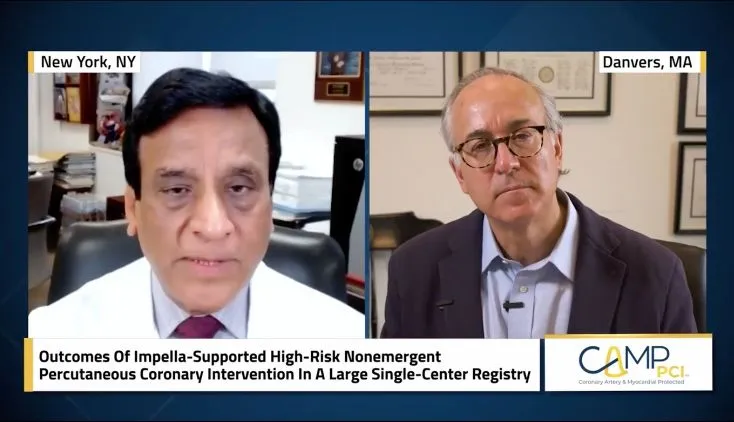Access & Closure, Axillary Access, Case Review, Intravascular Imaging, Protected PCI
Jason Wollmuth: Multivessel HRPCI Case Review
Jason Wollmuth, M.D., reviews a multivessel, high-risk PCI referral case involving Impella support via axillary single access and single operator rotational atherectomy. Dr. Wollmuth is an interventional cardiologist at Providence Heart and Vascular Institute in Portland, Oregon.
The patient was a 51-year-old woman with high-grade stenosis of the distal left main (LM) extending into the proximal circumflex and left anterior descending (LAD) artery with calcified disease as well as evidence of right coronary artery (RCA) disease. She was not a surgical candidate and was referred for multivessel PCI with hemodynamic support.
Dr. Wollmuth explains that Impella was indicated in this patient because she was undergoing multivessel PCI with a LM bifurcation lesion and an ostial RCA lesion, her left ventricular ejection fraction (LVEF) was 20%, she had acute decompensated heart failure with acute coronary syndrome (ACS), significantly elevated left ventricular end-diastolic pressure (LVEDP) and midodrine-dependent hypotension.
Dr. Wollmuth placed Impella using right axillary access with a 7Fr single access approach. He briefly reviews both axillary access best practices and the single access technique. In this case, there was poor perfusion in the hand after Impella placement, so Dr. Wollmuth created a bypass to the radial artery by connecting the sidearm of the Impella sheath to the sidearm of the radial sheath.
Dr. Wollmuth explains that axillary access is an excellent option for patients who have significant peripheral artery disease and for patients who may need longer term Impella support, because patients can ambulate with Impella placed in the axillary artery. As demonstrated in this case, he emphasizes the importance of managing complications such as arm ischemia and bleeding, and the need to have peripheral self-expanding covered stents available in case there is significant bleeding not controlled by tamponade measures.
Dr. Wollmuth describes how this case began with RCA PCI, delivering a stent to the proximal RCA. He then switched to the left coronary system, performing rotational atherectomy of the LAD. He describes a single operator rotablator delivery and removal, noting, “single operator rotational atherectomy is a great technique. It’s very simple and efficient. It eliminates the risk of wire movement and its useful for both delivery and removal of the rotablator.”
Dr. Wollmuth describes placement of several stents, including one to stabilized a mid LAD dissection, additional rotational atherectomy, left main bifurcation PCI, circumflex PCI with DK Crush and intravscular ultrasound (IVUS) imaging. He reports that the final angiography for this case showed, “an excellent angiographic result of the left main, of the LAD, and the circumflex.” He also highlights that both the jailed high obtuse marginal branch and high diagonal branch had good flow with no need for further intervention.
Dr. Wollmuth explains that after a slow wean in the cath lab, he removed Impella using a single access dry closure technique. The case took nearly three hours. The patient had an uneventful recovery from the procedure and was discharged on POD 4.
Dr. Wollmuth is compensated by and presenting on behalf of Abiomed, and must present information in accordance with applicable regulatory requirements. This presentation includes Dr. Wollmuth's opinions and findings based on their own knowledge and experience.
NPS-5168


